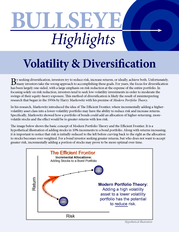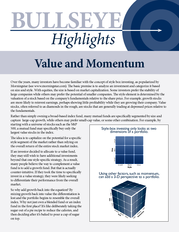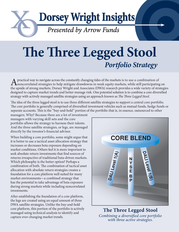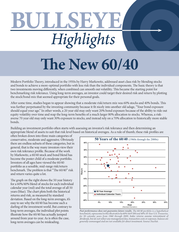Description
The table to the right shows the historical rolling
12-month correlations of various asset classes vs.
the S&P 500. The data shows shorter time periods
having higher correlations than their longer-term
averages might have initially indicated.
Increasing Correlations: Rolling 12-Month Averages vs. S&P 500
Long-Only
As of 6/30/2010
Long/Short
Perhaps searching for the optimal diversification
blend is a fool’s errand because asset classes rarely
seem willing to cooperate. The only consistent thing
about correlations is that they are constantly changing.
Markowitz based his research on long-term averages,
but short-term correlations tell quite a different story.
1 Yr
3 Yr
5 Yr
10 Yr
Bonds
0.282
0.070
0.026
(0.088)
International Stocks
0.913
0.861
0.788
0.824
Commodities
0.517
0.323
0.148
0.047
REITs
0.832
0.763
0.686
0.466
Alternatives
0.680
0.547
0.623
0.332
Managed Futures
0.350
0.017
0.103
(0.007)
Tactical
0.206
0.228
0.397
0.290
There’s an old saying: “The only thing that goes up in a down market is correlation.” Portfolios based on long-term
correlation data would have seemed to be fairly well positioned throughout the majority of the last decade.
But during the Financial Crisis of 2008-09, there was a clear spike in correlations across each of the traditional “buy & hold” long-only asset classes. Of those, only Bonds showed positive performance with annualized returns of 5.58%. On the other hand, long/short and tactical investments held their ground.
A blend of long/short Alternatives continued to add value despite an increase in correlation, losing an average of less than 1%. Managed Futures and the Tactical model both reduced their correlation while also posting positive annualized returns of 10.13% and 0.66%, respectively. Perhaps this is not unexpected, since managed futures and tactical strategies are typically designed to adapt to the market environment. Correlations During the 2000s: This illustration shows the difference in correlations across asset classes relative to the S&P 500 Index for the 2000s decade. The Blue Bars show the correlation during the first eight years of the decade (2000-2007). The Red Bars show the correlation during the 2008-2009 Financial Crisis. 2000-2007 Financial Crisis 2008-2009 1.00 0.80 0.60 0.40 0.20 0.00 (0.20) (0.40) Bonds International Commodities Stocks REITs Alternatives Managed Futures Tactical Conclusion: Achieving true diversification is not only about what you own, but also what you do with it.
Market volatility is difficult to avoid with a “buy & hold” long-only approach, especially when correlations spike. As the illustration above shows, long/short and tactical strategies have proven to be an effective way to help reduce the impact of correlation swings, while offering the potential for positive returns in difficult market environments. Past performance is not indicative of future returns. Historical data is used for statistical illustration purposes only and should not be used as a predictive measure for the future return expectations of any investment.
The information is subject to change (based on market fluctuation and other conditions) and should not be construed as a recommendation of any specific security or investment product, and was prepared without regard for specific circumstances and objectives of any individual investor. Both traditional and alternative investments involve risks, including the potential for loss of principal. Before investing in any financial product, always read the prospectus and/or offering memorandum for product-specific risks.
Data source: Morningstar.Asset class proxies: U.S. Stocks (S&P 500 Index); International Stocks (MSCI EAFE); Bonds (Barclays Aggregate Bond Index); Commodities (S&P GSCI); REITs (Wilshire REIT Index); Alternatives (Equal-weighted blend of C/S Tremont Hedged Equity, Fixed Income Arbitrage, and Managed Futures Indexes); Managed Futures (Trader Vic IndexTM); Tactical (DWA Global Macro). Index returns assume reinvestment of all dividends and do not reflect any management fees, transaction costs or expenses.
The indexes are unmanaged and are not available for direct investment.Trader Vic Index and “TVI” are trademarks of Enhanced Alpha Management, LP (EAM). EAM is not affiliated with Arrow Investment Advisors, LLC or Northern Lights Distributors, LLC, and does not sponsor or endorse the fund. The material provided herein has been provided by Arrow Investment Advisors and is for informational purposes only.
Arrow Investment Advisors serves as investment advisor to one or more mutual funds distributed through Northern Lights Distributors, LLC (member 1224-NLD-8/25/2010 FINRA). Northern Lights Distributors, LLC and Arrow Investment Advisors are not affiliated entities. .
But during the Financial Crisis of 2008-09, there was a clear spike in correlations across each of the traditional “buy & hold” long-only asset classes. Of those, only Bonds showed positive performance with annualized returns of 5.58%. On the other hand, long/short and tactical investments held their ground.
A blend of long/short Alternatives continued to add value despite an increase in correlation, losing an average of less than 1%. Managed Futures and the Tactical model both reduced their correlation while also posting positive annualized returns of 10.13% and 0.66%, respectively. Perhaps this is not unexpected, since managed futures and tactical strategies are typically designed to adapt to the market environment. Correlations During the 2000s: This illustration shows the difference in correlations across asset classes relative to the S&P 500 Index for the 2000s decade. The Blue Bars show the correlation during the first eight years of the decade (2000-2007). The Red Bars show the correlation during the 2008-2009 Financial Crisis. 2000-2007 Financial Crisis 2008-2009 1.00 0.80 0.60 0.40 0.20 0.00 (0.20) (0.40) Bonds International Commodities Stocks REITs Alternatives Managed Futures Tactical Conclusion: Achieving true diversification is not only about what you own, but also what you do with it.
Market volatility is difficult to avoid with a “buy & hold” long-only approach, especially when correlations spike. As the illustration above shows, long/short and tactical strategies have proven to be an effective way to help reduce the impact of correlation swings, while offering the potential for positive returns in difficult market environments. Past performance is not indicative of future returns. Historical data is used for statistical illustration purposes only and should not be used as a predictive measure for the future return expectations of any investment.
The information is subject to change (based on market fluctuation and other conditions) and should not be construed as a recommendation of any specific security or investment product, and was prepared without regard for specific circumstances and objectives of any individual investor. Both traditional and alternative investments involve risks, including the potential for loss of principal. Before investing in any financial product, always read the prospectus and/or offering memorandum for product-specific risks.
Data source: Morningstar.Asset class proxies: U.S. Stocks (S&P 500 Index); International Stocks (MSCI EAFE); Bonds (Barclays Aggregate Bond Index); Commodities (S&P GSCI); REITs (Wilshire REIT Index); Alternatives (Equal-weighted blend of C/S Tremont Hedged Equity, Fixed Income Arbitrage, and Managed Futures Indexes); Managed Futures (Trader Vic IndexTM); Tactical (DWA Global Macro). Index returns assume reinvestment of all dividends and do not reflect any management fees, transaction costs or expenses.
The indexes are unmanaged and are not available for direct investment.Trader Vic Index and “TVI” are trademarks of Enhanced Alpha Management, LP (EAM). EAM is not affiliated with Arrow Investment Advisors, LLC or Northern Lights Distributors, LLC, and does not sponsor or endorse the fund. The material provided herein has been provided by Arrow Investment Advisors and is for informational purposes only.
Arrow Investment Advisors serves as investment advisor to one or more mutual funds distributed through Northern Lights Distributors, LLC (member 1224-NLD-8/25/2010 FINRA). Northern Lights Distributors, LLC and Arrow Investment Advisors are not affiliated entities. .
Asset Management Presentations
+
Asset Management Sub Categories














